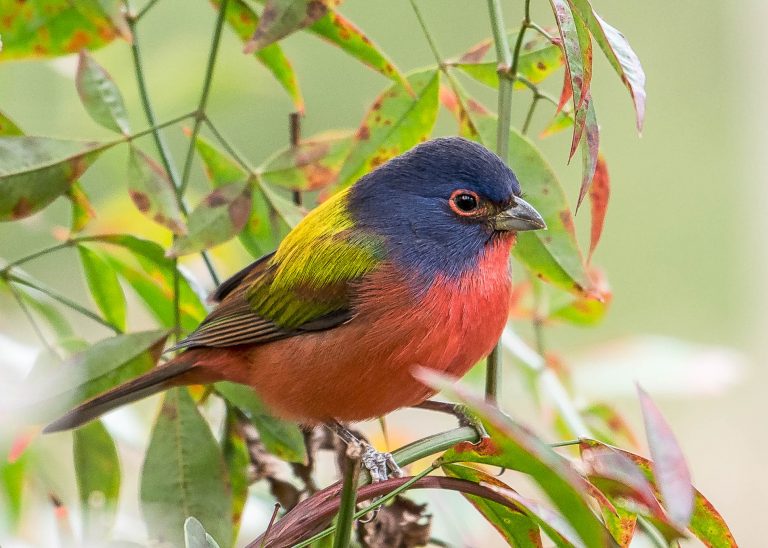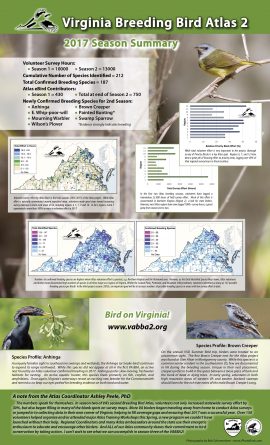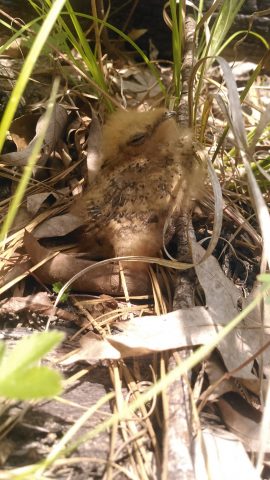By Ashley Peele

Painted Bunting (Copyright: Mary Catherine Miguez)
As the minds of many birders turn toward Christmas Bird Counts and the start of a new year of birding, project leaders and technicians are busily reviewing data collected by volunteers over the first two years of the second Virginia Breeding Bird Atlas (VABBA2). Assessing this living dataset is already a complex task, given the nearly half million records logged to the Atlas eBird portal since March 2016. However, as the State Coordinator, I must admit to relishing the task of digging into these records and seeing the discoveries Virginia birders have made in these two short years. For many species, a rough picture of current distribution is already beginning to form and comparison with the first VABBA’s findings starts to reveal just how much has changed over the last 30 years. I can’t help feeling a sense of pride in the VA birding community when viewing these first glimpses into our current breeding bird populations, because they would not exist without our committed volunteers.
The 2017 Seasonal Summary highlights many of the new findings and project accomplishments in this second field season, but let’s dig in to some of those numbers and figures a little more…
New Species Confirmations
Atlas volunteers added seven new species to our list of confirmed Virginia breeders in 2017. In Virginia’s coastal region, volunteers confirmed breeding Wilson’s Plovers and remarkably, strong evidence of breeding by a Painted Bunting pair (a first for Virginia). Given the sensitive nature of these species, details of these discoveries are being kept private, but we appreciate the careful efforts of Eastern Shore volunteers to collect these data. Moving slightly inland, the project’s first nesting pair of Anhinga was found via kayak in York county this summer. Abby Walter, a birder and graduate student from Virginia Commonwealth University, documented the first confirmed Eastern Whip-poor-will nest, coming upon the nest while conducting field work in Caroline county. Abby was kind enough to share photos of Whip nestlings, which she snapped before quickly moving away from the nest area. Continuing westward, volunteers confirmed the first Brown Creeper nest while on a VSO field trip in Montgomery county. Others identified Swamp Sparrows and Mourning Warblers in Highland county breeding in high elevation bog and forest habitats, respectively. Details of these findings can be viewed on the Atlas eBird portal.

Eastern Whip-Poor-Will Nestling (Abby Walter)
Appalachian Trail Atlas Volunteers
This year also saw a surge of Appalachian Trail hikers contributing breeding observations to the Atlas eBird portal. Most notably, Diana Doyle and her husband hiked the entire VA portion of the AT from north to south. Working with the Atlas PDF maps that allow volunteers to track their movements through Atlas blocks, Diana was able to submit checklists for specific Atlas blocks that she passed through. Over the course of her long trek through VA, Diana logged 216 checklists on 68 days, adding up to 283 hours of survey effort. Despite the challenge of setting a good backpacking pace and simultaneously watching for birds, Diana saw some fascinating wildlife interactions and collected many breeding observations. Stay tuned for a new article next spring about her atlasing adventures on the AT.
Birding Effort Across VA
Coverage and survey effort increased from our first to second season. The number of volunteer birding hours increased by 30% overall. Several rural regions of Virginia experienced significant boosts in survey hours, including a 243% boost in the southwestern VA’s region 7 and a 140% jump in central VA’s region 4. If we focus in on Atlas priority blocks, we find that birders in Northern VA’s region 2 and southeast VA’s region 12 continue to lead the charge with the greatest number of Priority blocks approaching completion (>15 hours of survey time). And lastly, volunteers in or visiting regions 6 (Eastern Shore), 7 (Southwest), and 12 (Southeast) have the highest proportions of hours logged to priority blocks.
As we move into the third breeding season, the VABBA2’s primary objectives will remain focused on completing blocks and moving on to untouched priority blocks. While we’re still working on a complete dataset review to assess block completion statewide, one easy rule may help you decide where to focus your efforts. First, if an Atlas block has more than 40-50 hours of effort, it is probably time to move on, because we need to do our best to allocate field time where it will be most beneficial. Spending 10 more hours in a well-surveyed block to confirm 2-3 more species will provide less insight into the breeding communities than logging 10 hours in a previously un-surveyed block. Later this winter, the VABBA2 will release more details on current block completions following the conclusion of the Atlas dataset review in early 2018.
Stay Tuned…
As part of this dataset review, new regionally focused materials will also be made available prior to the start of spring migration in 2018. These materials will include detailed regional maps highlighting block-level survey effort, species confirmations, and other data relevant to assessing survey needs. Additionally, we will be sharing more preliminary project results and interesting findings as the start our third season approaches. Be sure to stay tuned via social media, the Atlas email list-serv, and the Atlas eBird portal for these upcoming stories.
If you’d like to be added to the VABBA2’s email list-serv, please send your request to the state coordinator (ashpeele@vt.edu ). The Atlas Facebook page can be viewed at www.facebook.com/vabba2 and those interested in participating in the Atlas Facebook discussion group can visit www.facebook.com/groups/VABBA2 to join!
It is often the case that birding hotspots fall outside of Atlas priority blocks. In fact, many Atlas areas aren’t that exciting to visit. And yet, amazing pockets of breeding birds can be found in the most unlikely places (stay tuned for upcoming stories). To all the folks who have altered their birding routines to contribute much needed data to this project, we say a hearty thank you. We appreciate your dedication to citizen science and to the conservation of Virginia’s breeding birds.
Happy Holidays to all!
~Dr. Ashley Peele, State Coordinator, VABBA2


